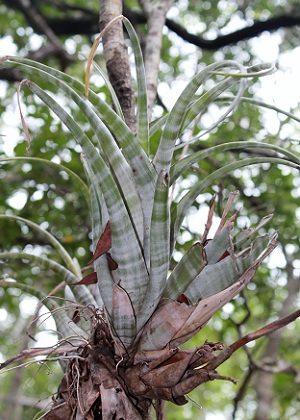
Copyright by: George D. Gann, 2013
In habitat, Everglades National Park, Key Largo, Florida
General Landscape Uses:
Primarily recommended for natural landscapes and habitat restorations. Also accent epiphtye.
Availability:
Grown by enthusiasts.
Description: Epiphytic herb.
Dimensions: 6-12 inches in height; up to 24 inches in flower. Usually taller than broad.
Growth Rate: Slow.
Range:
Monroe County Keys north to St. Lucie, Hendry and Charlotte counties; disjunct and very rare in Highlands County; West Indies, Central America and northern South America. Very rare in the middle Monroe County Keys.
 Map of select IRC data from peninsular Florida.
Map of select IRC data from peninsular Florida.
 Map of suggested ZIP codes from South Florida north to Jacksonville, Gainesville, and Cedar Key.
Map of suggested ZIP codes from South Florida north to Jacksonville, Gainesville, and Cedar Key.
 Map of ZIP codes with habitat recommendations from the Monroe County Keys north to Martin and Charlotte counties.
Habitats:
Map of ZIP codes with habitat recommendations from the Monroe County Keys north to Martin and Charlotte counties.
Habitats: Moist forests and swamps.
Soils: Epiphytic; grows on the trunks and branches of trees and shrubs.
Nutritional Requirements: Low; it grows on nutrient poor substrate.
Salt Water Tolerance: Low; does not tolerate long-term flooding by salt or brackish water.
Salt Wind Tolerance: Moderate; grows near salt water, but is protected from direct salt spray by other vegetation.
Drought Tolerance: High; does not require any supplemental water once established.
Light Requirements: Light shade.
Flower Color: White, rose, or purple.
Flower Characteristics: Semi-showy inflorescence.
Flowering Season: Spring-summer.
Fruit: Green to brown capsule with hairy, wind dispersed seeds.
Horticultural Notes: Can be grown from seed and division.
Comments: It is listed as threatened by the state of Florida.